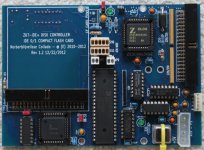** read above posts if you can donate, please do. **
-------- Original Message --------
Subject: RE: lost emails on SCSI to IDE/SD converter project
Date: Mon, 14 Jan 2013 21:03:42 -0500
From: "Andrew Lynch"
To: "'Ryan Wallmow'"
Cc: "'Rob Jarratt'" , "'Wayne Warthen'" , "'Norberto Collado'" , "'Douglas Goodall'" , , , , "'nestor ruiz'" , "'Clem Maloney'" , "'Geoffrey Reed'" , "'Matthew Hudson'" , , "'Miro Svetlik'" , "'..I'd rather be coding ASM!'" , "'Bob Devries'" , "'Marc Holz'" , "'Mark H. James'" , "'Mark Martin'" , "'Bob Grieb'"
Thank you Charles! I very much appreciate your efforts!
Have a nice day!
Andrew Lynch
SENT: Monday, January 14, 2013 5:07 PM
TO: Ryan Wallmow
CC: Rob Jarratt; Wayne Warthen; Andrew Lynch; Norberto Collado; Douglas
Goodall;
mouse@netbsd.org;
jwsmail@jwsss.com; Alan Hightower;
leonb@swiftdsl.com.au; nestor ruiz; Clem Maloney; Geoffrey Reed; Matthew
Hudson;
cotsco@frontiernet.net; Miro Svetlik; ..I'd rather be coding
ASM!; Bob Devries; Marc Holz; Mark H. James; Mark Martin; Bob Grieb
SUBJECT: Re: lost emails on SCSI to IDE/SD converter project
i am trying hard to get some more donations for this project!
On Jan 14, 2013, at 5:04 PM, Ryan Wallmow wrote:
With all this talk lately, I might have to work on mine again, I left
mine with all the sockets installed, but I hadn't yet started to
purchase components due to lack of funds and time, now that things have
changed, it gives me reason to go for it again ;-)
Good work everyone!
On Mon, Jan 14, 2013 at 3:58 PM, Rob Jarratt wrote:
This sounds like great progress! I need to find my last component and
then work out how to use the programmer to get the board to do something
(and find the time to do it!)
Regards
Rob
FROM: Wayne Warthen [mailto:wwarthen@gmail.com [2]]
SENT: 14 January 2013 02:22
TO: Andrew Lynch
CC: Norberto Collado; Douglas Goodall;
mouse@netbsd.org [3]; Charles
Phillips;
jwsmail@jwsss.com [4]; Alan Hightower;
leonb@swiftdsl.com.au
[5]; nestor ruiz; Clem Maloney; Geoffrey Reed; Matthew Hudson; Ryan
Wallmow;
cotsco@frontiernet.net [6]; Miro Svetlik; ..I'd rather be
coding ASM!; Bob Devries; Marc Holz; Mark H. James; Mark Martin; RobJ;
Bob Grieb
SUBJECT: Re: lost emails on SCSI to IDE/SD converter project
More progress this weekend. Still a long way to go, but this is good
stuff. I have been able to exchange data with a host initiator to the
point where the host knows the target is there and basic information
like it's name and capacity. Here are links to some pictures I just
posted on the Wiki. I can see the host asking for a "READ DATA" command
now, but have not had time to implement it, but very close.
LUN Discovery.jpg shows my test harness (Sergey's Xi8088 running a
Future Domain SCSI Controller). Notice that the SCSI device has been
detected and identified!
By the way, I am desperately seeking a good SCSI-1 reference...
Thanks,
Wayne

